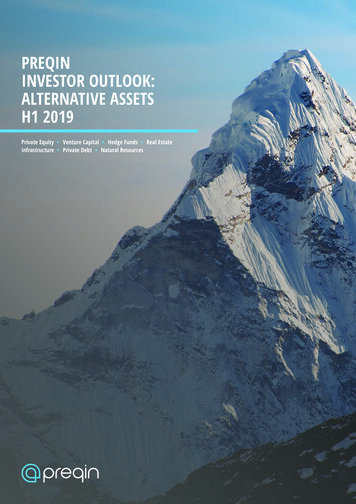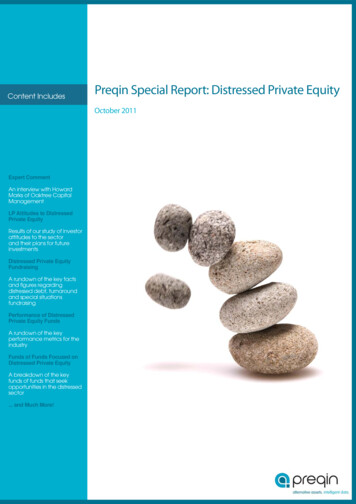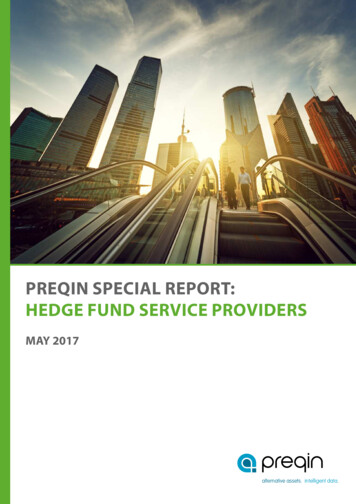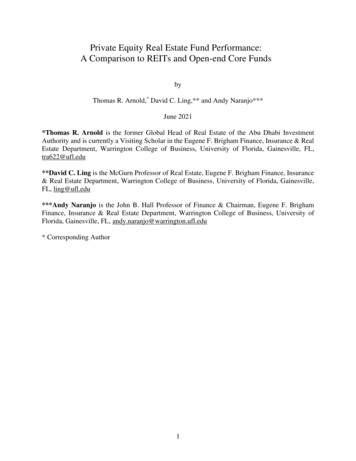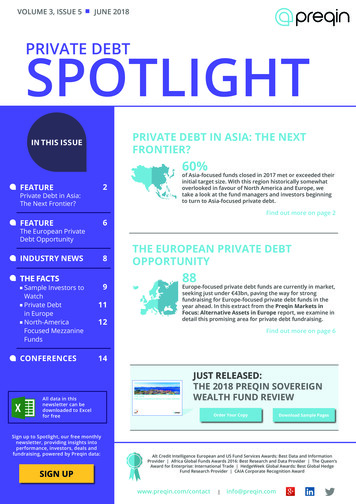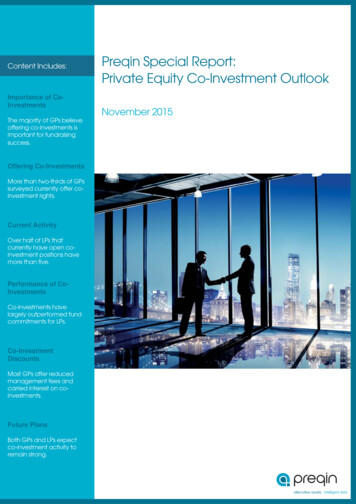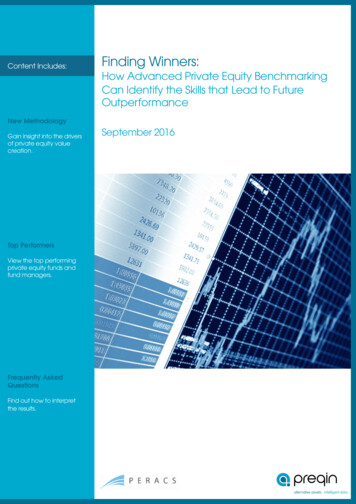
Transcription
Content Includes:Finding Winners:How Advanced Private Equity BenchmarkingCan Identify the Skills that Lead to FutureOutperformanceNew MethodologyGain insight into the driversof private equity valuecreation.September 2016Top PerformersView the top performingprivate equity funds andfund managers.Frequently AskedQuestionsFind out how to interpretthe results.alternative assets. intelligent data.
Preqin Special Report: Finding WinnersIntroductionProf. Oliver Gottschalg, Head of Research, PERACSPrivate equity performance measurement is by design initially about the “how much” of value creation of a given fund manager. Itis implicitly backward looking as today’s investors cannot “buy” a fund’s past returns but only commit to a manager’s future fundwith the hope of obtaining high returns from this investment.Commitment decisions to new funds would benefit by not only considering the absolute return of a fund but also by assessingthe GP skillset, i.e. the nature of value creation, as these skills of the GP are what ultimately persists between funds. To thisend PERACS have developed a novel methodology, the PERACS Manager Capability Identifier (MCI), to measure the distinctcomponents of a fund’s performance, leveraging data on tens of thousands of underlying investments made by thousands offunds. This enables us to assess and quantify the performance impact of distinct GP skills, and can thus provide the basis for adeeper understanding of the sources of past returns, as well as the persistence of different return components for a certain GPacross fund generations.The methodology uses a combination of performance and deals data from Preqin on 1,119 funds to decompose the relativeperformance impact of the “timing”, i.e. how investments were timed over the investment period of the fund; the “strategy”,i.e. which type of target companies were chosen (industry sector, size category, geography) to acquire at those times; and the“implementation”, i.e. the strategic development of the business, implementation of the GP’s value creation plans and managementappointments.Through our analysis of the data, we found that statistically significant positive persistence occurs only in the Implementationcomponent of returns. This is a particularly powerful message for private equity, as this component captures the impact the GPhas had during its stewardship of an investment, one of the key differentiators between private equity and other forms of assetmanagement.In this report, we highlight the top performing funds in terms of their Implementation Skill for different vintages and fund sizecategories as examples of funds that were particularly successful in generating better returns with their investments than those oftheir competitors, with similar approaches to investment timing and target selection. Further we present the various quartiles byImplementation Skill across the 2000s vintage years, to help in benchmarking a specific fund. Finally, we identify consistently topperforming managers in terms of this persistent Implementation Skill component.Professor Oliver GottschalgProfessor Oliver Gottschalg is Head of Research at PERACS, a specialized advisory firm providing advanced private equityfund due diligence and benchmarking services. He is part of the Strategy Department at HEC School of Management, Paris.He serves as HEC’s Academic Dean for the TRIUM Global Executive MBA Program, Director of the Entrepreneurship Trackin the HEC MBA program, directs the HEC Private Equity Observatory and teaches courses on strategy, entrepreneurship,venture capital financing and management buyouts. He holds a Wirtschaftsingenieur Diploma from the University ofKarlsruhe, an MBA from Georgia State University and a M.Sc. and PhD degree from INSEAD. His current research focuseson the strategic logic and the performance determinants of private equity investments. His work has been published inleading academic journals and in various publications for practitioners and was widely featured over 200 times in thebusiness press, radio and TV. He regularly presents his research at academic conferences and private equity symposiaand serves as an advisor to leading investors in the private equity industry. Most recently, he served as an advisor to theEuropean Parliament in the context of the current debate about a possible need for regulation of the private equity industry.www.peracs.comAll rights reserved. The entire contents of Preqin Special Report: Finding Winners, September 2016 are the Copyright of Preqin Ltd. No part of this publication or any information contained in it may be copied, transmitted by any electronicmeans, or stored in any electronic or other data storage medium, or printed or published in any document, report or publication, without the express prior written approval of Preqin Ltd. The information presented in Preqin Special Report:Finding Winners, September 2016 is for information purposes only and does not constitute and should not be construed as a solicitation or other offer, or recommendation to acquire or dispose of any investment or to engage in any othertransaction, or as advice of any nature whatsoever. If the reader seeks advice rather than information then he should seek an independent financial advisor and hereby agrees that he will not hold Preqin Ltd. responsible in law or equity forany decisions of whatever nature the reader makes or refrains from making following its use of Preqin Special Report: Finding Winners, September 2016. While reasonable efforts have been made to obtain information from sources that arebelieved to be accurate, and to confirm the accuracy of such information wherever possible, Preqin Ltd. does not make any representation or warranty that the information or opinions contained in Preqin Special Report: Finding Winners,September 2016 are accurate, reliable, up-to-date or complete. Although every reasonable effort has been made to ensure the accuracy of this publication Preqin Ltd. does not accept any responsibility for any errors or omissions within PreqinSpecial Report: Finding Winners, September 2016 or for any expense or other loss alleged to have arisen in any way with a reader’s use of this publication.2 2016 Preqin Ltd. / www.preqin.com
Preqin Special Report: Finding WinnersContentsOn the Methodology3Selected ResultsTop Performing Funds4Top Performing Fund Managers by MCI5Quartile Boundaries for Implementation Skill6Interpreting the Results7Frequently Asked Questions8On the MethodologyThe PERACS Manager Capability Identifier (“MCI”) compares the performance of various groups of private equity funds,classified by the nature of their underlying deals, to isolate the components of a fund’s outperformance to its peers. Itmeasures four distinct components of a PE fund’s performance, three of which are proxies for the underlying capabilitiesof the fund manager.This approach compares data on tens of thousands of underlying investments made by thousands of funds to identify funds thatare similar in three different aspects: (a) similar in the time period in which the fund was raised (three year vintage cycle), (b)similar in terms of when investments were made (based on acquisition years of the underlying deal) and (c) similar in terms ofwhich type of target companies were chosen (industry sector, size category, geography) to be acquired at those times.Starting from the funds raised in the same three-year vintage year cycle, the two remaining peer groups correspond to sequentiallyfiltering for funds that are similar to a given fund in terms of two key investment decisions of a PE firm: the Timing Choice, i.e. thedecision of how investments were timed over the investment period of the fund, and the Strategy Choice, i.e. the decision of whichtype of target companies were chosen (industry sector, size category, geography) to acquire at those times. It is then possible toassess the impact of each of these decisions by comparing the average performance among peer groups. Finally, the comparisonbetween a fund’s performance and the performance of those funds that are similar in terms of what was acquired and when,reflects the portion of a fund’s overall performance that is attributable to Implementation Skill, i.e. the performance of the specificinvestment approaches into specific target companies, above the returns of other funds that made similar decisions in terms oftiming and strategy.LPs use the methodology to derive new insights on value creation when evaluating potential GPs.GPs use the results to illustrate their relative value add and differentiation.The results should be compared to the GP’s articulated investment strategy, and can: Quantitatively help back-up a qualitative assessmentBe used as part of additional advanced due diligence with a GPHelp filter which GP from a number should be prioritized for additional due diligenceFor a more detailed explanation of the methodology and findings, please see “Beyond the Quartiles”, a white paper by OliverGottschalg, accessible at www.preqin.com/peracs3 2016 Preqin Ltd. / www.preqin.com
Preqin Special Report: Finding WinnersSelected ResultsTop Performing FundsTo determine the best performing funds, PERACS has grouped together funds into two categories: performance of funds greaterthan 1bn in size; and performance of funds between 250m and 1bn. The report is read as follows: The “Peers” column represents the average performance of funds (represented by the average MOIC/TVPI) within a twoyear vintage window of the target fund; The “Timing” column represents the impact of the Timing Choice on the returns of the fund; The “Strat” column represents the impact of the Strategy Choice decision on the returns of the fund; The “Implement” column represents the impact of the Implementation Skill on the returns of the fund; The “TVPI ” column represents the Total Value to Paid-in Multiple of the target fund i.e. the fund on which the analysis is run.Please see the Interpreting the Results section on page 7 for a more detailed explanation of the Timing, Strategy and Implementationfactors.Fig. 1: Top Performing Funds by Vintage: Funds Greater than 1bnFirmFundTypeRegionFocusFund Size( sta EquityPartnersVista Equity Fund ar-162001CVC CapitalPartnersCVC EuropeanEquity Partners 2002Berkshire PartnersBerkshire Fund un-152003Onex CorporationOnex 9630-Sep-152004Hellman & FriedmanHellman &Friedman -152005Goldman SachsMerchant BankingDivisionGS Capital .6230-Sep-152006TritonTriton Fund 007Vista EquityPartnersVista Equity Fund ep-152008MBK PartnersMBK Partners Odyssey InvestmentPartnersOdyssey InvestmentPartners Fund p-152010Lion CapitalLion Capital Fund VintageTVPI is based on the latest reported figure, which covers a two-year date range.Source: Preqin and PERACSRequest MCI MetricsPreqin has the data to compare the MCI metrics for over 1,100 funds worldwide. Should you wish to determine the metricsfor a specific fund, please reach out to us at: clientservices@preqin.com4 2016 Preqin Ltd. / www.preqin.com
Preqin Special Report: Finding WinnersFig. 2: Top Performing Funds by Vintage: Funds Greater than 250mn and Less than 1bnFirmFundTypeRegionFocusFund Size( P CapitalPartnersGreenhill 883.931-Dec-152001CBPE CapitalCBPE CapitalFund Wellspring CapitalManagementWellspring CapitalPartners -162003AltorAltor 2003 2004Herkules CapitalHerkules PrivateEquity Fund xcelAxcel 06Thoma BravoThoma CresseyFund p-152007H.I.G. CapitalHIG CapitalPartners 142008Thoma BravoThoma BravoFund 152009Egeria CapitalManagementEgeria PrivateEquity Fund 0WynnchurchCapital PartnersWynnchurchCapital Partners -15VintageSource: Preqin and PERACSTVPI is based on the latest reported figure, which covers a two year date range.Top Performing Fund Managers by MCIPERACS generates quartile rankings for individual funds according to their vintage. The quartile rankings are assigned using theImplementation Skill component of MCI which per PERACS research was identified as the most material and persistent measureof fund manager value add. The tables are compiled using only funds for which PERACS assigns a quartile ranking, and so forthis reason, funds with more recent vintages (2013, 2014, 2015 and 2016) have been excluded as these funds are too early intheir fund lives to generate meaningful return metrics. Only managers with three or more funds were considered to have enoughdata to be deemed consistent.The lower the average score, the more consistently the manager has outperformed its peers. The scores are calculated byassigning top-quartile funds with a score of one, second-quartile funds with a score of two and so on, and then an averageof the scores is taken. Only firms with average an quartile ranking of 2.00 or below are considered. No assurances as to thecompleteness of this list can be given; PERACS is limited to a sample of 1,100 funds based on the performance and deals dataavailable.Fig. 3: Consistently Top Performing Fund Managers by Implementation SkillFirmFirm LocationNo. ofFundsAverage Quartile Ranking ofImplementation SkillAltorUS31.00Clayton Dubilier & RiceUS31.00KPS Capital PartnersUS31.00Procuritas d Green & PartnersUS41.25American SecuritiesUS31.33Archer vest PartnersUS31.33Nautic PartnersUS31.33Odyssey Investment PartnersUS31.33Sentica PartnersFinland31.33Source: PERACS5 2016 Preqin Ltd. / www.preqin.com
Preqin Special Report: Finding WinnersQuartile Boundaries for Implementation SkillFig. 4: Median Implementation Skill and Quartile Boundaries by Vintage Year0.80Implementation Skill0.60Bottom QuartileImplementation SkillBoundary0.400.20Median ImplementationSkill0.00-0.20Top QuartileImplementation 052006200720082009201020112012Vintage YearSource: PERACSFig. 5: Median Implementation Skill and Quartile Boundaries by Vintage YearBottom Quartile ImplementationSkill BoundaryMedian ImplementationSkillTop Quartile ImplementationSkill e: PERACS6 2016 Preqin Ltd. / www.preqin.com
Preqin Special Report: Finding WinnersInterpreting the Results1. What does Timing Choice mean?This attribute measures the impact of the timing decision taken by a GP, namely, how investments were timed during theinvestment period of the fund.2. What does Strategy Choice mean?This attribute measures the impact of the decision taken by a GP as to which types of company they invest in, i.e. industry sector,investment size, and geography.3. What does Implementation Skill mean?This attribute measures relative stock selection value add of the GP in addition to the impact the GP has had during its stewardshipof an investment i.e. the strategic development of the business, implementation of its value creation plan, managementappointments etc; its ‘key ingredients’ of value creation.4. What does a positive score indicate?A positive score in a particular dimension indicates that the GP has taken decisions in that dimension that led it to performbetter than the average fund’s GP in the reference group, as described above in the Timing Choice, Strategy Choice andImplementation Skill descriptions.What a positive Timing Choice score indicates: This GP took timing decisions that improved its performance over the universeof funds raised in the same five-vintage-year period.What a positive Strategy Choice score indicates: This GP made choices related to the industry, size and geography ofthe acquired assets that improved its performance over those funds raised in the same five-vintage-year period that madecomparable timing decisions.What a positive Implementation Skill score indicates: This GP was better able to implement its chosen investment strategy thanthose funds raised in the same five-vintage-year period that made comparable timing and strategy decisions.5. What does a negative score indicate?A negative score in a particular dimension indicates that the GP has taken decisions in that dimension that led it to performworse than the average fund’s GP in the reference group, as described above in the Timing Choice, Strategy Choice andImplementation Skill descriptions.6. Which is more important: Timing Choice, Strategy Choice, or Implementation Skill?While each of these attributes is important, a user needs to firstly compare the results to the articulated strategy and approachof the GP in question to help answer questions such as: “Is the key skill of this GP its ability to be a great market timer?” Onlythe Implementation Skill shows positive persistence of returns which would imply this characteristic is the most important onewhen selecting future outperformers.7. How do I benchmark the relative score sizes?Identify a set of GPs that are comparable from your perspective and look at the relative score they each have in the different MCIcomponents.8. How do I interpret these scores and apply this to the other diligence I am completing on the target GP?This methodology helps a user identify the sources of value creation by a GP in an objective, formulaic and independent manner.The results need to be compared to the GP’s articulated investment strategy, and can either quantitatively help back-up thequalitative assessment of a GP and/or be used as part of additional advance due diligence with a GP and/or help filter which GPfrom a number a user would like to prioritize for additional due diligence.7 2016 Preqin Ltd. / www.preqin.com
Preqin Special Report: Finding WinnersFrequently Asked Questions1. Why is understanding MCI important?Understanding how a GP creates value is important as it gives a greater insight into the nature of the skills of a particular GP,which can be compared to the way their strategy is articulated. More importantly, performance driven by a GP’s ImplementationSkill shows persistence over time, and hence is a strong indicator that the GP has a higher chance of continuing to perform inthe future.2. Is a strong Implementation Skill Score an indicative feature to demonstrate persistence?Yes.3. How is the universe of comparables calculated?A competitor ‘Peer Universe’ is created by identifying all funds raised in a similar period to the GP in question, i.e. those fundsraised in /- 2 years of the GP’s defined vintage year. Within this universe we then filter to only include funds with similar timingof investments and then filter again to only include funds with a similar strategy, i.e. similarity in terms of the size, the industryand the geography of the underlying assets, to the GP in question.4. What data is needed to run the analysis on a fund?In order to run the analysis we need the net-to-LP performance data of the fund as well as at least five deals from the fundincluding information on the size, timing, sector and location of that deal.5. How does this Peer Universe differ from the traditional vintage year approach?This approach creates a Peer Universe based on the similarity of underlying deals done by the GP in question to consider GPswhich have also completed similar deals rather than the often used method of creating a peer set based on the vintage year afund happened to be raised in.6. How big is the universe for funds?There was sufficient data to run the analysis on 1,119 PE funds.7. How big is the universe for deals?Information on 26,771 PE-backed deals was used to support the analysis of the 1,119 funds.8. How many funds are typically in the five year vintage group peer set?On average five times more than in a typical vintage year.9. Can I see which funds make up the peer benchmark for a target fund?Identifying similarity based on the underlying deals a fund makes as opposed to vintage year often leads to non-traditional resultsthat require a more detailed explanation of the methodology. To understand more about the peer set for a given fund pleasecontact PERACS directly at info@peracs.com10. What are the limitations of this methodology?While this methodology has been designed to provide directionally correct insights despite possible imperfections in theunderlying data on fund performance and investment activity, the method only considers deals that actually happened. As suchit cannot capture that funds may have been in regular competition for similar deals, but eventually ended up making investmentsthat were not very similar as per our definition of similarity.Data limitations prohibit us from considering other deal attributes than size, industry and geography, so that we do not capturewhich fund are similar with respect to their choice of buy-and-build versus standalone buyout strategies. The method uses netto-LP performance data only. Based on the way that similarity is determined the method inherently assumes that deal size anda deal’s impact on overall fund TVPI are perfectly aligned. While this may not hold true for individual funds, we find that acrossa universe of 1000 funds these factors are highly correlated. Given the above, the Strategy choice metric for specialist fundsis often understated.For a detailed explanation of the methodology, or the results for a specific fund, please contact Preqin client services:clientservices@preqin.com.8 2016 Preqin Ltd. / www.preqin.com
Preqin Special Report:Finding WinnersSeptember 2016Preqin: Global Data and IntelligenceWith global coverage and detailed information on all aspects of the private equity assetclass, Preqin’s industry-leading Private Equity Online service keeps you up-to-date on allthe latest developments in the private equity universe.Source new investors for funds and co-investmentsFind the most relevant investors, with access to detailed profiles for over 6,300 institutionalinvestors actively investing in private equity, including future fund searches and mandates,direct contact information and sample investments.Identify potential investment opportunitiesView in-depth profiles for over 1,700 private equity funds currently in market, includinginformation on investment strategy, geographic focus, key fundraising data, serviceproviders used and sample investors.Find active fund managers in private equitySearch for firms actively targeting private equity investments. View information on keycontacts, firm fundraising and performance history, and applied strategies of the firm wheninvesting in portfolio companies and assets.Analyze the latest private equity fundraising activitySee which firms are currently on the road raising a private equity fund and which will becoming to market soon. Analyze fundraising over time by fund strategy and location.See the latest buyout and venture capital deals and exitsView details of more than 153,000 buyout and venture capital deals, including deal value,buyers, sellers, debt financing providers, financial and legal advisors, exit details and more.Identify forthcoming exits and expected IPOs.Benchmark performanceIdentify which fund managers have the best track records, with performance benchmarksfor private equity funds and performance details for over 5,700 individual named funds.Examine fund termsSee the typical terms offered by funds of particular types, strategies and geographical foci,and assess the implications of making changes to different fees.For more information, please visit:If you would like any furtherinformation, or a demo of ourproducts, please contact us:New York:One Grand Central Place60 E 42nd Street, Suite 630New YorkNY 10165Tel: 1 212 350 0100Fax: 1 440 445 9595London:3rd FloorVintners’ Place68 Upper Thames StreetLondonEC4V 3BJTel: 44 (0)20 3207 0200Fax: 44 (0)87 0330 5892Singapore:One Finlayson Green, #11-02Singapore 049246Tel: 65 6305 2200Fax: 65 6491 5365San Francisco:One Embarcadero CenterSuite 2850San FranciscoCA 94111Tel: 1 415 316 0580Fax: 1 440 445 9595Hong Kong:Level 9, Central Building1-3 Pedder StreetCentral, Hong KongTel: 852 3958 2819Fax: 852 3975 2800ManilaPascor DriveSto. NiñoParañaque CityMetro Manila 1700Philippineswww.preqin.com/privateequityEmail: info@preqin.comWeb: www.preqin.com 2015 Preqin Ltd. / www.preqin.com
He serves as HEC's Academic Dean for the TRIUM Global Executive MBA Program, Director of the Entrepreneurship Track in the HEC MBA program, directs the HEC Private Equity Observatory and teaches courses on strategy, entrepreneurship, venture capital fi nancing and management buyouts. He holds a Wirtschaftsingenieur Diploma from the University of

